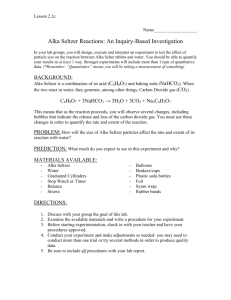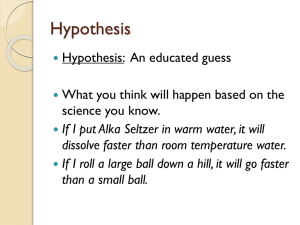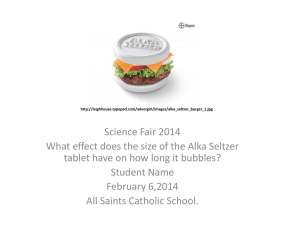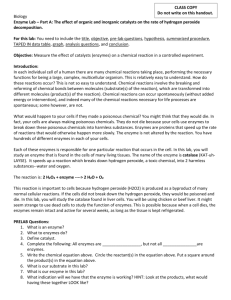HASPI Teacher Template Rough – reaction rates
advertisement
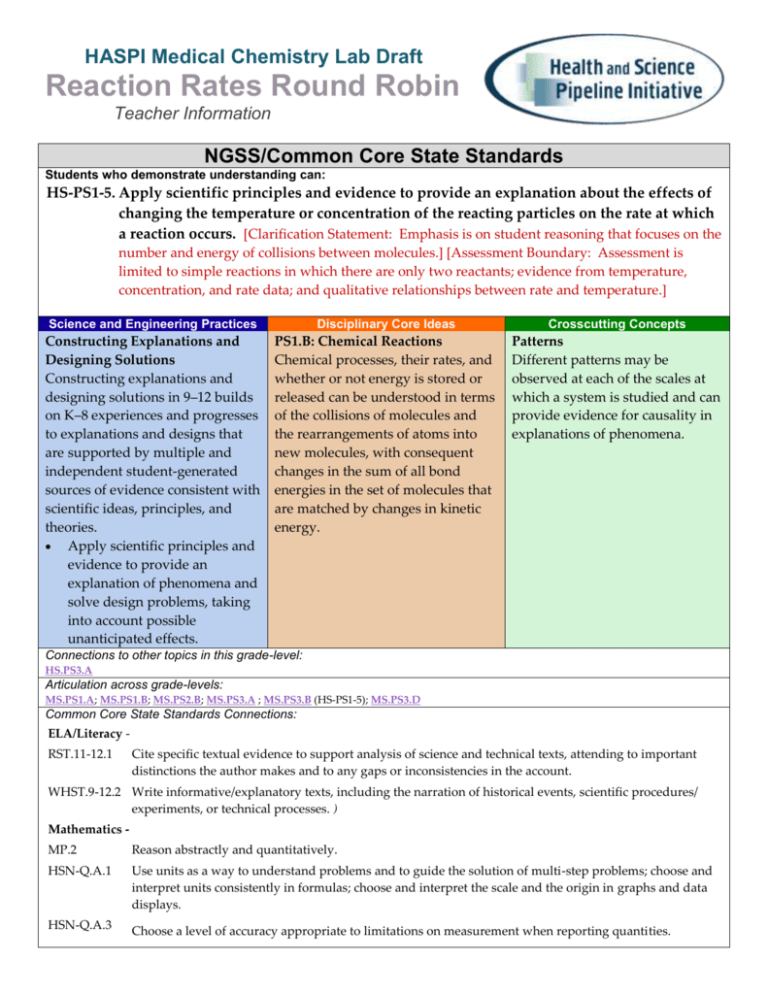
HASPI Medical Chemistry Lab Draft Reaction Rates Round Robin Teacher Information NGSS/Common Core State Standards Students who demonstrate understanding can: HS-PS1-5. Apply scientific principles and evidence to provide an explanation about the effects of changing the temperature or concentration of the reacting particles on the rate at which a reaction occurs. [Clarification Statement: Emphasis is on student reasoning that focuses on the number and energy of collisions between molecules.] [Assessment Boundary: Assessment is limited to simple reactions in which there are only two reactants; evidence from temperature, concentration, and rate data; and qualitative relationships between rate and temperature.] Science and Engineering Practices Disciplinary Core Ideas Crosscutting Concepts Constructing Explanations and Designing Solutions Constructing explanations and designing solutions in 9–12 builds on K–8 experiences and progresses to explanations and designs that are supported by multiple and independent student-generated sources of evidence consistent with scientific ideas, principles, and theories. Apply scientific principles and evidence to provide an explanation of phenomena and solve design problems, taking into account possible unanticipated effects. PS1.B: Chemical Reactions Chemical processes, their rates, and whether or not energy is stored or released can be understood in terms of the collisions of molecules and the rearrangements of atoms into new molecules, with consequent changes in the sum of all bond energies in the set of molecules that are matched by changes in kinetic energy. Patterns Different patterns may be observed at each of the scales at which a system is studied and can provide evidence for causality in explanations of phenomena. Connections to other topics in this grade-level: HS.PS3.A Articulation across grade-levels: MS.PS1.A; MS.PS1.B; MS.PS2.B; MS.PS3.A ; MS.PS3.B (HS-PS1-5); MS.PS3.D Common Core State Standards Connections: ELA/Literacy RST.11-12.1 Cite specific textual evidence to support analysis of science and technical texts, attending to important distinctions the author makes and to any gaps or inconsistencies in the account. WHST.9-12.2 Write informative/explanatory texts, including the narration of historical events, scientific procedures/ experiments, or technical processes. ) Mathematics MP.2 Reason abstractly and quantitatively. HSN-Q.A.1 Use units as a way to understand problems and to guide the solution of multi-step problems; choose and interpret units consistently in formulas; choose and interpret the scale and the origin in graphs and data displays. HSN-Q.A.3 Choose a level of accuracy appropriate to limitations on measurement when reporting quantities. Interpretation & Description In this lab students will explore the effect of Surface Area, Temperature, Stirring, Catalysts, Enzymes and Concentration on how a medication reacts. The specific description of the medical application is found on each station, however reaction rate is a key concept in the study of Pharmaceuticals as it can affect how a medication works, its effectiveness, its degradation, the possibility of overdose and much more. This is a Round Robin activity where students will find a different variable at each station. Place the directions in a plastic sleeve at each station and hand out the answer sheet for students to bring to each station. At the station they will first read the background and medical application and answer questions about it. They will then hypothesize about the potential outcome of the lab. They will do the listed procedure, writing their observations as they go. Finally they will create a concluding sentence that specifies what they learned at that station. Station 1: Surface Area involves students running two reactions using Alka Seltzer tablets and water. Students will increase the surface area of the Alka Seltzer tablet by grinding it up in one reaction and leave the other whole. The effects of surface area on the rate of a chemical reaction can be applied to differences in “time-release” medications. At Station 2: Temperature students will run another pair of reactions with Alka Seltzer tablets and water. One reaction will use room temperature water while the other uses warm water that has been heated on a hot plate. The effects of temperature on the rate of a chemical reaction can be applied to the importance of storing certain drugs at specific temperatures. If certain drugs are not stored at proper temperatures they will break down quicker, greatly affecting their efficacy. Station 3: Stirring & Mixing involves students comparing two reactions between Sodium Bicarbonate (Baking Soda) and vinegar. One of the reactions will be left alone while the other will be stirred with a stirring rod. The effects of stirring & mixing on the rate of a chemical reaction can be applied to the importance of muscle contraction in the breakdown of food and absorption of nutrients throughout the digestive system. At Station 4: Catalyst students are asked to make observations of the breakdown of Hydrogen Peroxide (H2O2) in a container all by itself and in a container with a platinum catalyst. The container and catalyst that are used at this station are the same as the ones found in contact lens cleaning kits. The medical background at this station, as well as Station 5: Enzymes, gives insight to the destructive properties of Hydrogen Peroxide, which is a very common compound in the human body. Station 5: Enzymes also involves the breakdown of Hydrogen Peroxide. Students will read more about the destructive properties of H2O2 and how the human body has enzymes like catalase to counteract those destructive properties. At this station students will add common foods that contain catalase ( garlic, potato, and spinach) to H2O2 to see what effect it may have on the rate of reaction. Station 6: Concentrations involves running two Alka Seltzer reactions in soapy water. In one container students will only add 1/3 of a tablet while the other will contain 2/3 of a tablet. The effects of concentrations on the rate of chemical reactions can be applied to figuring out the correct dosage of medications and running the risk of an overdose. Allow for up to 5 minutes to have students read the background and answer questions, then 5 more minutes for the lab and analysis. You may use a 5 minute timer to keep students on track, and so that all students move at the same time. Learning Target By the end of class students will be able to observe and predict the changes in reaction rates with changes in surface area temperature molecular motion concentrations, applications of catalysts and enzymes. Time Actual Time (please make note below) Estimated Time Station 1: Surface Area – 10-15 minutes Station 2: Temperature – 10-15 minutes Station 3: Stirring & Mixing - 10-15 minutes Station 4: Catalysts - 10-15 minutes Station 5: Enzymes - 10-15 minutes Station 6: Concentration - 10-15 minutes * allow 5 minutes to read and answer questions, then 5 minutes to do the lab and respond. You can easily cut out stations if you are limited on time, or do the lab over more than one class period. Note: Share the actual time on forum (www.haspi.org) or at HASPI curriculum conference Materials Station 1 Surface Area 2 250mL beakers 1 mortar and pestle 1 tablet of Alka-Seltzer per group 200mL water per group Station 2 Temperature 2 250mL beakers 1 large hot plate 1 tablet of Alka-Seltzer per group 200 mL Water per group Station 3 Stirring 2 125mL Erlenmeyer flasks Balance small weigh boat 1.5 g sodium bicarbonate per group stirring rod 100mL of Vinegar per group Station 4 Catalyst 2 50mL beakers 1 ClearCare or similar contact case with platinum disc 50mL of Hydrogen Peroxide per group Station 5 Enzymes 8 test tubes Mortar and Pestle Potato Spinach Garlic 10mL Hydrogen peroxide per group Station 6 Concentration 2 100mL graduated Cylinders Soapy Water 1 Alka-Seltzer per group *Make the soapy water ahead of time by adding dish soap to water and mixing. You will need a total of Supply Provided (P) or Needed (N) Quantity Company/ Item # Approximate Cost Station 1: Surface Area Alka Seltzer Tablets P 30 packs of 2 Mortar and pestle P 2 Sodium bicarbonate P 30 g Vinegar P 2000 mL Hydrogen Peroxide P 1000 mL Soapy Water P 2000 mL Water N 100mL x 4 Spinach N 1 bag Potato N 20 1/2 inch cube pieces Garlic N 20 1/2 inch cube pieces 250 mL beaker N 4 50 mL beaker N 4 125 mL Erlenmeyer flask N 4 Balance N 2 Hot Plate N 2 100mL graduated cylinder N 4 Test Tubes N 8 Small weigh boat N 2 Stir rod N 2 Graduated Cylinder N 2 Common Student Misconceptions Additional Misconception Notes: Students may have trouble making a hypothesis. You will want to talk about how to make a testable hypothesis, provide them with the possible hypotheses, or provide sentence starters. o You may want to have a class discussion and write out all hypothesis possible and have students pick one. Students can have trouble differentiating between dissolving and reacting. You might review the different signs of a chemical reaction and talk about the bubbles as proof of a reaction. You can also discuss the specific reaction between Alka-seltzer and water. Alka-Seltzer contains citric acid and sodium bicarbonate. By dissolving them in water they can come into contact and react with each other. Guiding Questions Many guiding questions are in the "pre-lab" portion of this lab. This means the lab can be done at any point in the unit. As an inquiry activity the students will get a preview of the concepts they will learn, or you can do the lab after teaching the concepts in order to solidify their understanding. Key idea/questions to discuss: What causes a reaction? Have students write out and balance each reaction that occurs. What signs provide evidence for a reaction taking place? What variables change reaction rate? What mechanisms can speed up/slow down reaction rates? Why would you want to speed up/slow down reaction rates? Compare and contrast the words catalyst and enzyme. Explain the difference between catalyst and inhibitor. Discuss the difference between the rate of a reaction and the amount of reaction that takes place. Additional Information Information Page # Location Resources and References http://antoine.frostburg.edu/chem/senese/101/consumer/faq/why-does-alkaseltzer-fizz.shtml Images (in order of appearance) http://antoine.frostburg.edu/chem/senese/101/consumer/faq/why-does-alkaseltzer-fizz.shtml
